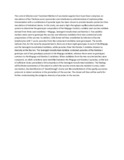| dc.contributor.author | Patel, Ekta H | |
| dc.contributor.author | Lubembe, Donald M | |
| dc.contributor.author | Gachanja, James | |
| dc.contributor.author | Mwaura, Stephen | |
| dc.contributor.author | Spooner, Paul | |
| dc.contributor.author | Toye, Philip | |
| dc.date.accessioned | 2015-11-02T11:21:02Z | |
| dc.date.available | 2015-11-02T11:21:02Z | |
| dc.date.issued | 2011-06 | |
| dc.identifier.citation | Veterinary Parasitology Volume 179, Issues 1–3, 30 June 2011, Pages 62–68 | en_US |
| dc.identifier.uri | http://www.sciencedirect.com/science/article/pii/S0304401711000914 | |
| dc.identifier.uri | http://hdl.handle.net/11295/92208 | |
| dc.description.abstract | The current Infection and Treatment Method of vaccination against East Coast fever comprises an inoculation of live Theileria parva sporozoites and simultaneous administration of oxytetracycline. Immunization with a combination of parasite types has been shown to provide broader protection than inoculation of individual strains. In this study, we used a high-throughput capillary electrophoresis system to determine the genotypic composition of the Muguga Cocktail, a widely used vaccine stabilate derived from three seed stabilates—Muguga, Serengeti-transformed and Kiambu 5. Five satellite markers were used to genotype the vaccine and reference stabilates from two commercial-scale preparations of the vaccine. In addition, 224 cloned cell lines established by infection of bovine lymphocytes with T. parva parasites from the component stabilates were genotyped. The results indicate that, for the recently prepared batch, there are at least eight genotypes in each of the Muguga and the Serengeti-transformed stabilates, while parasites from the Kiambu 5 stabilate showed no diversity at the five loci. The Serengeti-transformed stabilate contained parasites of the Kiambu 5 genotype and of two genotypes present in the Muguga stabilate, whereas there were no genotypes common to the Muguga and Kiambu 5 stabilates. When stabilates from the two vaccine batches were compared, no allelic variations were identified between the Muguga and Kiambu 5 parasites, while lack of sufficient clones prevented a full comparison of the Serengeti-transformed stabilates. The findings will facilitate examination of the extent to which the vaccine strains become resident in areas under vaccination, the identification of ‘breakthrough’ strains and the establishment of the quality assurance protocols to detect variations in the production of the vaccine. The cloned cell lines will be useful for further understanding the antigenic diversity of parasites in the vaccine. | en_US |
| dc.language.iso | en | en_US |
| dc.publisher | University of Nairobi | en_US |
| dc.subject | Theileria parva; East Coast fever; Infection and Treatment Method; Vaccine | en_US |
| dc.title | Molecular characterization of live Theileria parva sporozoite vaccine stabilates reveals extensive genotypic diversity | en_US |
| dc.type | Article | en_US |
| dc.type.material | en | en_US |

